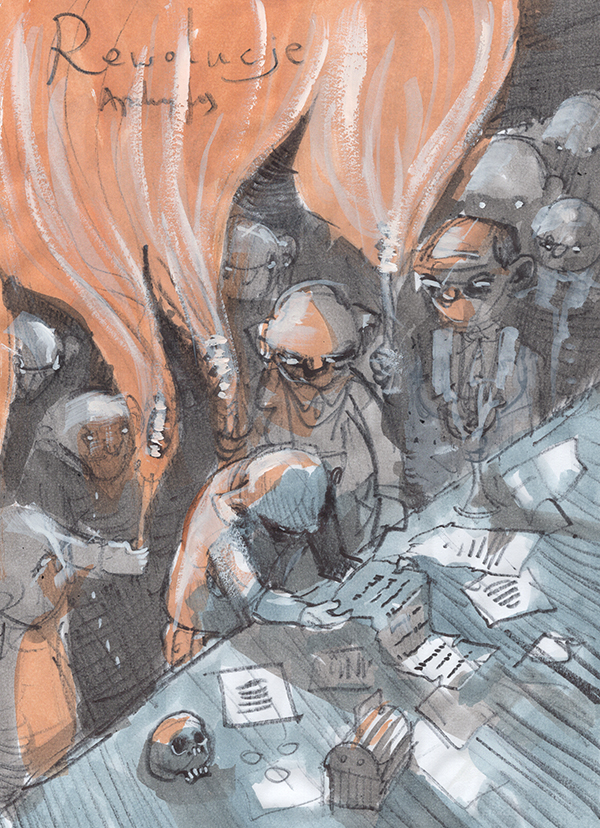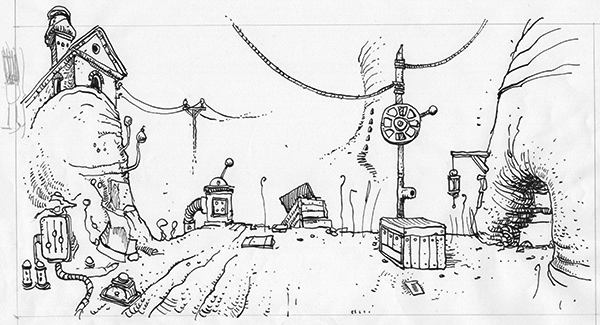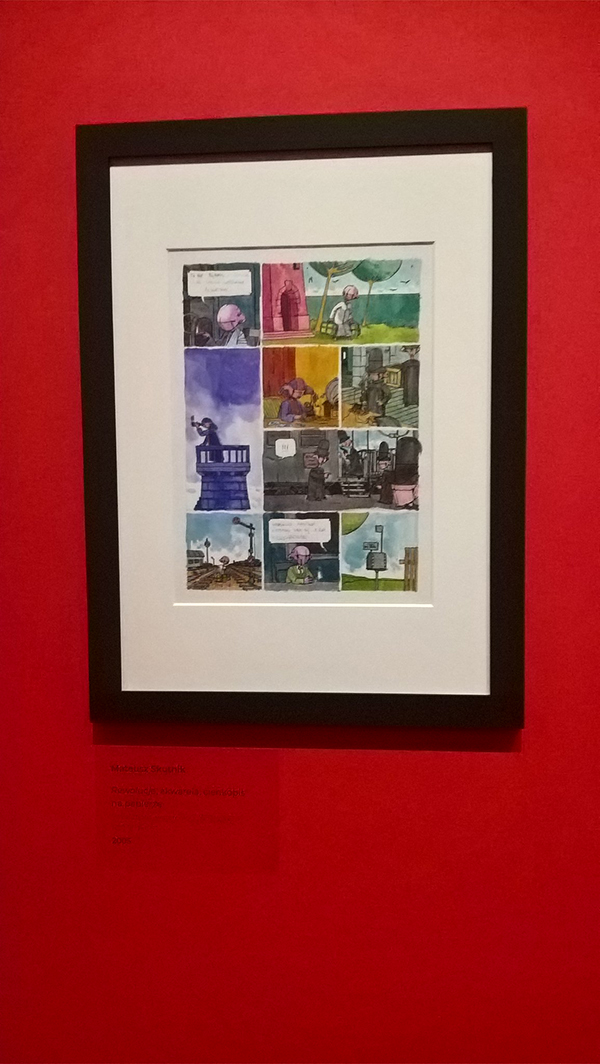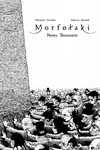Rewolucje 11; cover sketch
May 15, 2018


This was the moment I decided that the game will be drawn by hand. Made this sketch, then compared it in-game with another drawing made in flash and the difference in game-feel was just striking.

Wystawa od 2 Marca 2018.
Po raz pierwszy w historii Muzeum Narodowe w Krakowie organizuje wystawę prezentującą oryginalne prace, wydawnictwa i przedmioty z lat 1871-2017, związane z komiksem w Polsce. Wszystkie eksponaty pochodzą z prywatnej kolekcji Wojciecha Jamy – jednego z kuratorów wystawy. Zobaczyć będzie można ponad 600 obiektów, w tym: szkice, plansze, blaudruki, albumy z rysunkami i autografami, a także książki, katalogi, czasopisma, druki ulotne oraz unikalne figurki, zabawki, monety, znaczki oraz przedmioty codziennego użytku.
Foto: Jan Kleszczyński
If the game doesn’t open and you get this message:
Could not display “game name”.
There is no application installed for executable files.
Do you want to search for an application to open this file?
You have probably need to make the game file executable.
Right click on the game file, click on Properties, choose the tab Permissions. Check the small square Allow executing file as program.
~~~~
Written by Edwin Vigneau.
The following are instructions to run the linux versions on certain linux distributions in which they do not run out of the box.
All commands are to be entered in a terminal.
A 64-bit linux distribution is required.
Debian 9 (“Stretch”)
libssl1.0.0 is missing and it is not in the repositories. Install it from the “Jessie” repositories or download it from https://packages.debian.org/jessie/amd64/libssl1.0.0/download
Fedora 27
openal is missing, install it with:
su -c ‘dnf install openal-soft.x86_64’
libGLU is missing, install it with:
su -c ‘dnf install mesa-libGLU.x86_64’
libssl1.0.0 and libcrypto.so.1.0.0 are missing, but they are not in the repositories or even available as a package. We need to compile them from the source code.
If you don’t have gcc, install it with:
su -c ‘dnf install gcc’
Download the source code from:
https://www.openssl.org/source/old/1.0.0/openssl-1.0.0s.tar.gz
Extract the archive
Open a terminal in the extracted directory
compile it with:
./config shared
make
Move the compiled libraries to their proper place with:
sudo cp libssl.so.1.0.0 /lib64/libssl.so.1.0.0
sudo cp libcrypto.so.1.0.0 /lib64/libcrypto.so.1.0.0
The game should run now.
~~
If your distribution is not mentioned here and the game does not run, start the game from a terminal.
If there are missing libraries, their name will be shown so that you can install them.
They may not be in your distribution’s repositories however, since some are quite outdated.
You may have to compile them from source.
Hi there, Linux / Ubuntu users!
Today is your day. I finally managed to harness the knowledge of creating virtual machine, installing Ubuntu on it and connecting it to my good ol’ PC work station. Thus, linux versions are now a reality. Get them all here:
These builds were created to the exact specifications of Game Maker Studio 2.
I used Ubuntu 14.04.5 LTS (Trusty Tahr) as instructed by the how-to page.
They say it’s the only version of Ubuntu they support right now that creates stable builds of games.
If you run into problems while trying to run those games (missing libraries etc), read this troubleshoot article written by Edwin Vigneau.
Believe me, connecting Ubuntu Virtual Machine to Game Maker Studio 2 on my PC is kind of a peak of my tech-savviness when it comes to Linux. The process is then automated, therefore tweaking it by me myself is out of the question for me.
However, I hope majority of you will be able to open and play these games! A side note: this only concerns games from 2017, which were created in Game Maker Studio 2. Games from 2016 were done in a previous version of the studio without access to Linux versions. Buying that access on a defunct and unused engine now seems a bit redundant, doesn’t it?
(Yes, that also means that all my future releases will be available on Linux on premiere day as well).
Happy days ahead!
Lately I found this small article from 5 years ago. I noticed that the time span in that article was also 5 years. Which means 10 Gnomes were created as a concept 10 years ago. Somehow that fact hit me more than when Submachine turned 10. Somehow I was ready for Submachine being this old, but Gnomes?… Well, time flies, as usual. Now’s the moment to time stamp this occasion.
Also: a quick study on how to completely destroy a city skyline by building skyscrapers without proper urban design. Sheesh.
[ click on pictures to zoom in ]
 Świat Morfołaków jest tak rozbudowany, że można o nim czytać na okrągło i nie odnieść wrażenia, że coś się powtarza. Po zamknięciu komiksu długo trzeba się zastanawiać, co właśnie przed chwilą nas trafiło i czy to było naprawdę? Mateusz Skutnik narysował teraz to, co istniało pod postacią scenariuszy już w momencie wydania zbiorczego z 2007 i to, co Nikodem Skrodzki dopisał. Niezwykła to frajda czytać tamten stary zapis scenarzysty, a potem porównywać z narysowaną na jego podstawie do Nowego Testamentu historyjką. Ale frajda jest też z odkrywania tego bardzo namacalnego świata, którego istnienie czuje się pod skórą, z odkrywania jego mechanizmów i poszukiwania w nim logiki. Morfołaki robią coś takiego z głową, że wielu rzeczy pozornie się nie zapamiętuje, ale potrafią się one wryć w podświadomość i powrócić przy każdej kolejnej lekturze z siłą huraganu Katrina. Mistrz.
Świat Morfołaków jest tak rozbudowany, że można o nim czytać na okrągło i nie odnieść wrażenia, że coś się powtarza. Po zamknięciu komiksu długo trzeba się zastanawiać, co właśnie przed chwilą nas trafiło i czy to było naprawdę? Mateusz Skutnik narysował teraz to, co istniało pod postacią scenariuszy już w momencie wydania zbiorczego z 2007 i to, co Nikodem Skrodzki dopisał. Niezwykła to frajda czytać tamten stary zapis scenarzysty, a potem porównywać z narysowaną na jego podstawie do Nowego Testamentu historyjką. Ale frajda jest też z odkrywania tego bardzo namacalnego świata, którego istnienie czuje się pod skórą, z odkrywania jego mechanizmów i poszukiwania w nim logiki. Morfołaki robią coś takiego z głową, że wielu rzeczy pozornie się nie zapamiętuje, ale potrafią się one wryć w podświadomość i powrócić przy każdej kolejnej lekturze z siłą huraganu Katrina. Mistrz.